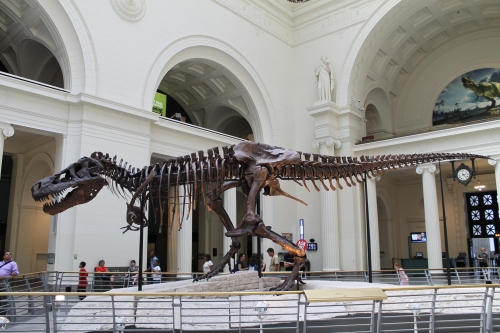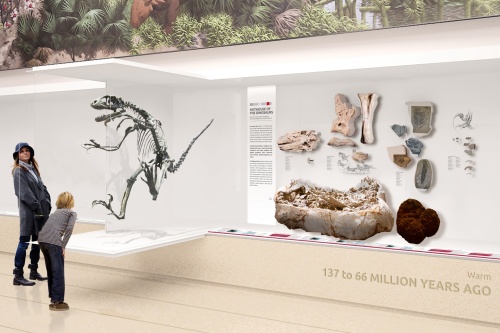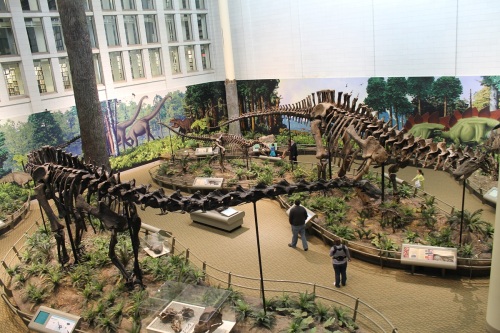Phylogenetics is the study of the evolutionary history and relationships among extant and extinct organisms. More than any other organizational scheme, this is the way biologists think about the living world. In vertebrate paleontology in particular, an understanding of the evolutionary relationships of animals as identified via minute anatomical details is absolutely fundamental to our science. One might even argue that most new discoveries and inferences in this field are meaningless without some knowledge of the basic shape of the tree of life.
I’ve spent about eight years so far teaching science in museums, parks, and classrooms. And based on my anecdotal experience, most discussion of phylogeny comes across as incomprehensible babble to a plurality of people. For instance, one of the most commonly used definitions of “dinosaur” among paleontologists is “the most recent common ancestor of Triceratops and modern birds, and all it’s descendants” (there’s also the similar “most recent common ancestor of Megalosaurus and Iguanodon, and all it’s descendants”). This definition is not meaningful to most people. As evidence, I submit the following set of questions, all of which I have been asked by intelligent and well-meaning adults:
- Did whales and dolphins evolve from marine reptiles?
- Did giraffes evolve from sauropods?
- Are [dromaeosaurs] related to cats?
- Are dinosaurs related to sharks?
- How can birds be dinosaurs if dinosaurs are reptiles?
- Did the plant-eating dinosaurs evolve into mammals?
- Are bats a kind of bird?
- Are pterodactyls a kind of bird?
I don’t mean to ridicule or disparage people for asking these questions. Again, these all come from educated adults – museum and park visitors, undergraduate students, T.A.s, and at least one veterinarian! While these questions clearly show unfamiliarity with evolutionary relationships and how evolution works in general, they also show an effort to build a logical framework when none is available. For example, when a person asks if whales are descended from marine reptiles, he or she is hypothesizing that all large marine animals are related. This is incorrect, but it’s a sensible connection to make (and one that past naturalists have certainly explored).
For science communicators, this deficit of phylogenetic understanding is a serious problem which continuously undermines attempts to interpret zoology and paleontology. For example, think about how little meaning a statement like “Dimetrodon isn’t a dinosaur” has to somebody who can’t articulate what a mammal is or what a dinosaur is, much less the evolutionary distance between both groups. This is what we should expect from most of our audience, which means there is always a lot of catch-up work to do when explaining something as simple as the basic identity of a given organism. By the time you’ve satisfactorily defined “dinosaur” (good luck with that), explained the synapsid-diapsid split, discussed the tree of extinct stem-mammals, and positioned each of these things in deep time, you’re five minutes deep into a lecture when all you were asked was “what is it?”
How can we solve this conundrum? The first step is to divide the issue into a number of smaller problems:
- People don’t understand the fundamentals of how evolution works
- People are unfamiliar with basic vertebrate classification
- People lack knowledge of key evolutionary events through deep time
- People don’t understand what traits are significant when assessing evolutionary relationships
The first problem is well known and has been discussed in-depth elsewhere (e.g. MacFadden et al. 2007, Spiegel et al. 2006, Spiegel et al. 2012), so I’m going to breeze over it and focus on the other three.
Basic Vertebrate Classification
It’s easy to toss out words like “mammal”, “reptile”, and “amphibian”, and take for granted that your audience will know what they mean. But even the most basic elements of vertebrate classification are specialized knowledge, and science communicators would do well to remember it. When I was teaching an undergraduate human anatomy course, I found that most of the class was familiar with the word “mammal”, and could name some examples. However, the students couldn’t articulate what sets mammals apart from other animals, and the relationship of mammals to other vertebrates within the tree of life was all new to them.
I think this is fairly typical, even among individuals with a background in biology. People are introduced to these categories in grade school, and you’d be hard-pressed to find somebody who couldn’t tell you whether (say) a cat is a mammal or a reptile. What is missing is what that actually means. We can’t assume that just because somebody knows a cat is a mammal, they know that fur and milk glands (much less auditory ossicles, a solid mandible, and heteromorphic teeth) are things to look for when categorizing mammals. They also may not know that “mammal” is an evolutionary group – that all the animals that fall under this banner are more closely related to each other than they are to anything else. No mammal is going to spontaneously become a bird or a fish. This is obvious to specialists, but not to most of our audience.
Evolutionary History Through Deep Time
The situation is further complicated by the element of time. Somebody may know that a modern cat and lizard differ in several fundamental ways, but do they know that both groups still evolved from a common ancestor? Or that said ancestor lived more than 300 million years ago? Unfortunately, much of the public would appear to lack any knowledge of how the past is related to the present. I’ve had visitors insist on calling fossil turtles “dinosaur turtles” and Teleoceras a “rhino-saur.” For them, extinct animals (all labeled “dinosaurs”) are a category all their own, wholly independent from the categories that describe modern animals.
For specialists, it’s obvious that modern animals exist within a continuum that extends into the deep past. It’s also obvious that groups like “mammals” and “reptiles” had starting points, and are embedded within larger, more ancient groups. None of this can be considered common knowledge, but it’s critical to any discussion about the identity or categorization of a given taxon.

Box diagrams are a simple and intuitive way to ground students’ understanding of the diversity of life.
How can educators hope to cover so much ground without confusing, distracting, or alienating their audiences? One option is to use a cladogram, or evolutionary tree. Trees are absolutely the most precise and accurate way to portray relationships over time, but as Torrens and Barahona demonstrate, they are regularly misinterpreted by the public. When I’m dealing with a general audience, I prefer box diagrams like the one above. Boxes within boxes show tiers of relatedness in a way that is more intuitive and easily understood than a tree. Box diagrams allow educators to cover a lot of unfamiliar ground quickly, and it’s easy to test visitors’ comprehension by asking them to point to where an example taxon should be placed. While this visualization of vertebrate relationships lacks a time axis, people can at least grasp the relative order in which each group evolved (fish before amphibians, amphibians before reptiles and mammals, etc).
How Scientists Discover Evolutionary Relationships
Going back to the list of misguided questions at the top of this post, we can generally surmise the thought process that led to each inquiry. The person who asked if whales and marine reptiles are related was classifying based on shared habitat. The person who asked if giraffes evolved from sauropods was classifying based on similar body shape. We can also see classifications based on diet, and based on shared activities, like flight or attacking prey with clawed feet. All these questions reflect a misunderstanding of what kinds of traits researchers look for when working out evolutionary relationships. So how do we quickly and clearly explain which traits are relevant, and which ones are not?
This is a tricky problem, and one I have not found a perfect solution to. The most important distinction is between plesiomorphic and apomorphic traits: plesiomorphic traits are inherited from an ancestral form, while apomorphic traits are novel developments. Put simply, working out a phylogenetic tree is all about grouping organisms based on shared apomorphies. The more apomorphic traits between two species, the more closely related they are. Once introduced, this is a fairly intuitive distinction. You don’t even need to use the jargon – “old traits” and “new traits” will often suffice. Going back to our problem of defining Dimetrodon, we can clarify that the lizardy shape and general toothiness are “old traits” – so they don’t tell us much about what the animal actually is. Instead, scientists look at “new traits”, like the number of postorbital fenestrae, to work out Dimetrodon‘s evolutionary affinities.
All of this is a long-winded way of saying that relating phylogeny to the public is challenging, but very important. Too often, science educators assume visitors have more background than they do, and the discussion comes across as so much moon man talk. Alternatively, educators push past complicated parts too quickly, which leads to confusion or misunderstanding. Ultimately, being a good educator comes down to two things: knowing your content and knowing your audience. Both are equally important, and both need to be practiced and refined in equal measure to ensure successful communication.
References
Macfadden, B.J., Dunckel, B.A., Ellis, S., Dierking, L.D., Abraham-Silver, L., Kisiel, J., and Koke, J. 2007. BioScience 57:10:875-882.
Spiegal, A.N., Evans, E.M., Gram, W., and Diamond, J. 2006. Museums and Social Issues 1:1:69-86.
Spiegel, A.N., Evans, E.M., Frazier, B., Hazel, A., Tare, M., Gram, W., and Diamond, J. 2012. Changing Museum Visitors’ Conceptions of Evolution. Evolution: Education and Outreach 5:1:43-61.
Torrens, E. and Barahona, A. 2012. Why are Some Evolutionary Trees in Natural History Museums Prone to Being Misinterpreted?” Evolution: Education and Outreach 1-25.















 I’ve never written a book review here before, but Karen A. Rader and Victoria E.M. Cain’s Life on Display: Revolutionizing U.S. Museums of Science and Natural History in the 20th Century is a fine place to start. Published in 2014, this fascinating and exhaustively researched volume follows the struggle of natural history museum workers to define the purpose of their institutions. Ultimately, are museums places for exhibits, or places for collections? Rader and Cain chart the internal and external perceptions of natural history museums through time, recounting the people and events that made these institutions what they are. If you have a serious interest in science communication or the history and philosophy of science, Life on Display is a must-read.
I’ve never written a book review here before, but Karen A. Rader and Victoria E.M. Cain’s Life on Display: Revolutionizing U.S. Museums of Science and Natural History in the 20th Century is a fine place to start. Published in 2014, this fascinating and exhaustively researched volume follows the struggle of natural history museum workers to define the purpose of their institutions. Ultimately, are museums places for exhibits, or places for collections? Rader and Cain chart the internal and external perceptions of natural history museums through time, recounting the people and events that made these institutions what they are. If you have a serious interest in science communication or the history and philosophy of science, Life on Display is a must-read.















































